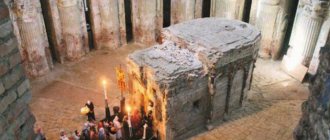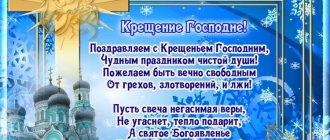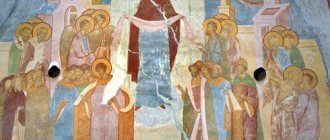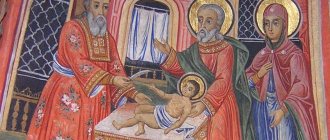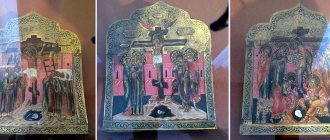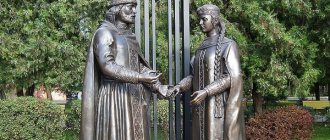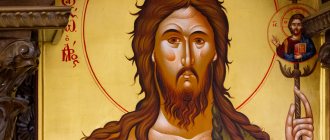What kind of holiday is this day
The celebration of the Exaltation began several decades after Christ was crucified. The messengers had to bring to the church the cross on which the crucifixion took place. However, they found 3 crosses at once. To determine the desired item, seriously ill people were touched with crosses. It was possible to cure a seriously ill woman and resurrect a dead man. The life-giving cross was placed on a high mountain, and people from other countries came to see it.
On this day, the church is being improved. If the clergy ordered domes, they must be placed on the Exaltation.
There is an opinion that on September 27 there is a struggle between good and evil. The cross symbolizes the victory of good over evil. In addition to the Exaltation, on September 27, people celebrate the Third Autumn. This day also falls on the “name day”. Therefore, many traditions and rituals are not only religious, but also folk in nature.
Russian Orthodox Church
The event of finding the Honest Cross. After the greatest events in the history of mankind took place - the Crucifixion, Burial, Resurrection and Ascension of Christ, St. The cross, which served as the instrument of execution of the Savior, was lost. After the destruction of Jerusalem by Roman troops in 70, holy places associated with the earthly life of the Lord fell into oblivion, and pagan temples were built on some of them.
The discovery of the Honorable Cross took place during the reign of St. Equal-to-the-Apostles Emperor Constantine the Great. According to church historians of the 4th century, Constantine’s mother, St. Equal to the Apostles Helen, at the request of the royal son, went to Jerusalem to find places connected with the events of the earthly life of Christ, as well as St. The cross, the miraculous appearance of which appeared to St. Constantine is a sign of victory over the enemy.
Three different versions of the legend about the finding of St. Cross. According to the most ancient one (it is given by the 5th century church historians Rufinus of Aquileia, Socrates, Sozomen and others and probably goes back to the lost “Ecclesiastical History” of Gelasius of Caesarea (IV century)), the Holy Cross was located under the pagan sanctuary of Venus. When the sanctuary was destroyed, three crosses were discovered, as well as a tablet from the Cross of the Savior and the nails with which He was nailed to the instrument of execution. In order to find out which of the crosses was the one on which the Lord was crucified, Bishop Macarius of Jerusalem (+ 333) proposed applying each of the crosses in turn to a seriously ill woman. When she was healed after touching one of the crosses, all those gathered glorified God, who pointed to the greatest shrine of the True Tree of the Cross of the Lord, and the Honest Cross was raised by Bishop Macarius for everyone to see.
The second version of the legend about the discovery of the Honorable Cross, which arose in Syria in the 1st half. V century, refers this event not to the IV, but to the III century. and says that the Cross was found by Protonika, the wife of the emperor. Claudius II (269–270), and then hidden and rediscovered in the 4th century.
The third version, also apparently arose in the 5th century. in Syria, reports that St. Elena tried to find out the location of the Cross from the Jerusalem Jews, and in the end one elderly Jew named Judas, who at first did not want to talk, after torture indicated the place - the Temple of Venus. St. Helena ordered to destroy the temple and excavate this place. 3 crosses were found there; A miracle helped to reveal the Cross of Christ - the resurrection through touching the True Tree of a dead man who was being carried past. It is reported about Judas that he subsequently converted to Christianity with the name Cyriacus and became the bishop of Jerusalem.
Despite the greatest antiquity of the first version of the legend about the finding of the Honorable Cross, in the middle and late Byzantine era the third version became the most widespread; in particular, it is based on the prologue legend, intended to be read on the Feast of the Exaltation of the Cross according to modern liturgical books of the Orthodox Church.
The exact date of the acquisition of the Honorable Cross is unknown; Apparently, it took place in 325 or 326. After the discovery of St. After the Cross, Emperor Constantine began the construction of a number of churches, where services were to be performed with the solemnity befitting the Holy City. Around 335, the large basilica Martyrium, erected directly near Golgotha and the Cave of the Holy Sepulcher, was consecrated. The Day of Renewal (i.e., consecration) of the Martyrium, as well as the rotunda of the Resurrection (Holy Sepulcher) and other buildings on the site of the Crucifixion and Resurrection of the Savior on September 13 or 14 began to be celebrated annually with great solemnity, and the memory of the discovery of the Honorable Cross was included in the festive celebration in honor of Updates.
The establishment of the Feast of the Exaltation of the Cross is thus connected with the holidays in honor of the consecration of the Martyrium and the Rotunda of the Resurrection. According to the “Easter Chronicle” of the 7th century, the rite of the Exaltation of the Cross was first performed during the festivities during the consecration of Jerusalem churches.
Already at the end. IV century the feast of the Renewal of the Basilica of the Martyrium and the Rotunda of the Resurrection was one of the three main holidays of the year in the Jerusalem Church, along with Easter and Epiphany. According to the testimony of the pilgrims IV century Egeria, the Renewal was celebrated for eight days; every day the Divine Liturgy was solemnly celebrated; churches were decorated in the same way as on Epiphany and Easter; Many people came to Jerusalem for the holiday, including from distant regions - Mesopotamia, Egypt, Syria. Egeria emphasizes that the Renewal was celebrated on the same day when the Cross of the Lord was found, and also draws a parallel between the events of the consecration of the Jerusalem churches and the Old Testament temple built by Solomon (“Pilgrimage.” Ch. 48–49).
The choice of September 13 or 14 as the date of the Renewal holiday could be due both to the very fact of the consecration of churches on these days, and to a conscious choice. According to a number of researchers, the Feast of Renewal has become a Christian analogue of the Old Testament Feast of Tabernacles, one of the three main holidays of Old Testament worship (Lev 34.33–36), celebrated on the 15th day of the 7th month according to the Old Testament calendar (this month roughly corresponds to September) , especially since the consecration of Solomon's Temple also occurred during Tabernacles. In addition, the date of the feast of renewal on September 13 coincides with the date of the consecration of the Temple of Jupiter Capitolinus in Rome, and a Christian holiday could be established to replace the pagan one (this theory was not widely spread). Finally, there are possible parallels between the Exaltation of the Cross on September 14 and the day of the Crucifixion of the Savior on Nisan 14, as well as between the Exaltation of the Cross and the Feast of the Transfiguration, celebrated 40 days before. The question of the reason for choosing September 13 as the date of the celebration of the Renewal (and, accordingly, September 14 as the date of the Feast of the Exaltation of the Cross) has not been finally resolved in modern historical science.
Renewal and Exaltation of the Cross. In the 5th century, according to the testimony of the church historian Sozomen, the Feast of Renewal was celebrated in the Jerusalem Church as before very solemnly, for 8 days, during which “even the sacrament of Baptism was taught” (Church History. 2.26). According to the 5th century Jerusalem Lectionary, preserved in an Armenian translation, on the second day of the Feast of Renewal, the Holy Cross was shown to all the people. Thus, initially the Exaltation of the Cross was established as an additional holiday accompanying the main celebration in honor of the Renewal - similar to the holidays in honor of the Mother of God on the day after the Nativity of Christ or St. John the Baptist the day after the Epiphany.
Since the 6th century. The Exaltation of the Cross gradually began to become a more significant holiday than the Feast of Renewal. If in the Life of St. Sava the Sanctified, written in the 6th century. St. Cyril of Scythopolis also speaks of the celebration of the Renewal, but not the Exaltation (chapter 67), then already in the Life of St. Mary of Egypt, traditionally attributed to St. Sophronius of Jerusalem (VII century), it is said that St. Mary went to Jerusalem to celebrate the Exaltation (chapter 19).
The very word “exaltation” (ypsosis) among the surviving monuments is first found in Alexander the Monk (527–565), the author of a eulogy to the Cross, which should be read on the feast of the Exaltation of the Cross according to many liturgical monuments of the Byzantine tradition (including modern Russian liturgical books). Alexander the Monk wrote that September 14 is the date of the celebration of the Exaltation and Renewal, established by the fathers by order of the emperor (PG. 87g. Col. 4072).
By the 7th century the close connection between the holidays of the Renewal and the Exaltation of the Cross ceased to be felt - perhaps due to the Persian invasion of Palestine and their plunder of Jerusalem in 614, which resulted in the capture of the Holy Cross by the Persians and the partial destruction of the ancient Jerusalem liturgical tradition. Yes, St. Sophronius of Jerusalem in his sermon says that he does not know why on these two days (Sept. 13 and 14) the Resurrection precedes the Cross, that is, why the Feast of the Renewal of the Church of the Resurrection precedes the Exaltation, and not vice versa, and that the reason for this could have been known to more ancient bishops (PG. 87g. Col. 3305).
Subsequently, it was the Exaltation of the Cross that became the main holiday; the holiday of the Renewal of the Jerusalem Church of the Resurrection, although preserved in liturgical books up to the present time, became a pre-holiday day before the Exaltation of the Cross.
Feast of the Exaltation of the Cross in the cathedral worship of Constantinople in the 9th–12th centuries. In Constantinople, the holiday of the Renewal of the Jerusalem churches did not have the same significance as in Jerusalem. On the other hand, the veneration of the Venerable Tree of the Cross of the Lord, which began under St. Equal to the Apostles Emperor Constantine and especially intensified after the victorious return of St. The Exaltation of the Cross by Emperor Heraclius from Persian captivity in March 631 (this event is also associated with the establishment of calendar commemorations of the Cross on March 6 and on the Cross Worship Week of Lent), made the Exaltation of the Cross one of the great holidays of the liturgical year. It was within the framework of the Constantinople tradition, which in the post-iconoclastic period became decisive in the worship of the entire Orthodox world, that the Exaltation finally surpassed the Feast of the Renewal. According to various lists of the Typicon of the Great Church, reflecting the post-iconoclast conciliar practice of Constantinople in the 9th–12th centuries, the celebration of the Exaltation of the Cross is a five-day festive cycle, including a four-day period of pre-celebration on September 10–13 and the feast day on September 14. Particular importance is also attached to Saturday and Sunday days before and after the Exaltation, which received their own liturgical readings.
The veneration of the Holy Cross began already on the days of the forefeast: on September 10 and 11, men came to venerate, and on September 12 and 13, women. Worship took place between matins and noon.
On the day of the holiday, September 14, the divine service was distinguished by solemnity: the day before, a festive vespers was performed with the reading of proverbs; for the sake of the holiday, pannikhis was served (a solemn service at the beginning of the night); Matins was performed according to the festive rite (“on the pulpit”); after the great doxology, the rite of the Exaltation of the Cross was performed. At the end of the Exaltation and veneration of the Cross, the Divine Liturgy began.
In the Byzantine post-iconoclast monastic Typicons, the charter for the holiday of the Exaltation of the Cross received its final form. The body of holiday chants according to these Typicons is generally the same; the holiday has a pre- and post-celebration; liturgical readings for the holiday, Saturdays and weeks before and after the Exaltation are borrowed from the Typikon of the Great Church; The rite of the Exaltation of the Cross at the festive morning was also borrowed from the Constantinople cathedral tradition, which is somewhat simplified in comparison with that one. In the Jerusalem Charter, starting from its early editions of the 12th–13th centuries. there is an indication of fasting on the day of the Exaltation of the Cross. St. Nikon Montenegrin (11th century) in “Pandects” wrote that fasting on the day of the Exaltation is not indicated anywhere, but is a generally accepted practice.
According to the Jerusalem Charter now accepted in the Orthodox Church, the festive cycle of the Exaltation of the Cross consists of a pre-celebration on September 13 (combined with the feast of the Renewal of the Jerusalem Church of the Resurrection), a holiday on September 14 (in the XX-XXI centuries - September 27 in the new style) and seven days of post-feast, including delivery on September 21st.
Holiday chants. Compared to the hymnography of other twelve holidays, not all hymns of the Exaltation of the Cross are connected specifically with this event; many of them are part of the hymns of the cross of Octoechos (at services on Wednesdays and Fridays of all voices), as well as in the succession of other holidays in honor of the Cross: The Origin of the Honest Tree of August 1, Appearance of the sign of the Cross in the sky on May 7, the week of the Cross in Great Lent, that is, they constitute a single body of hymnographic texts dedicated to the Cross of the Lord.
A number of chants following the V. holiday traditionally include prayers for the Emperor and petitions to grant him and his army victory. In modern Russian publications, many lines containing petitions about the Emperor were either deleted or reformulated, which was due to historical circumstances. The reason for the appearance of such petitions should be seen in the Orthodox understanding of the Cross as a sign of victory (which made the Cross part of Byzantine military symbolism), as well as in the fact that the discovery of the Cross and the establishment of the Feast of the Exaltation took place thanks, first of all, to the saints Equal-to-the-Apostles Constantine and Helen. The latter is confirmed by the presence of a special memory of St. Constantine and Helena in the Sinai Canonar of the 9th–10th centuries. September 15, that is, the day after the Exaltation (the establishment of this memory expresses the same idea as the establishment of the memory of the Most Holy Theotokos on the day after the Nativity of Christ or the memory of St. John the Baptist on the day after the Baptism of the Lord - immediately after the event those persons are glorified , which were of paramount importance for its implementation).
The hymnographic sequence of the Exaltation of the Cross contains the troparion Save, O Lord, Thy people..., kontakion Who ascended to the Cross by will..., canon of St. Cosmas of Mayum, a large number of stichera (22 samoglas and 5 cycles of similar ones), 6 sedals and 2 luminaries. There is only one canon in the succession of the Exaltation of the Cross, but the ninth canto in it includes not one, but two irmos and two cycles of troparia, and the last four letters of the acrostic from the eighth canto and the first group of troparia from the ninth canon of the canon are duplicated in the second group of troparia of the ninth canon. The unusual nature of this structure of the canon is explained by the legend preserved on Athos, according to which St. Cosmas of Mayum, having come to Antioch for the feast of the Exaltation of the Cross, heard in one church that his canon was not being sung to the tune that he himself had in mind when composing the canon. St. Cosma reprimanded the singers, but they refused to correct the mistake; then the monk revealed to them that he was the compiler of the canon, and as proof he composed another group of troparions for the ninth canto. The Byzantine interpretations of this complexly written canon have been preserved in the manuscripts, on the basis of which St. Petersburg wrote his own interpretation (which is very famous in the Greek Churches). Nicodemus Svyatogorets.
Based on materials from an article by Deacon Mikhail Zheltov and A.A. Lukashevich “The Exaltation of the Cross of the Lord” from volume 9 of the “Orthodox Encyclopedia”
See also: Today, brethren, the Holy Cross is raised... (Teaching for the Feast of the Exaltation of the Honest Cross from the service Prologue), The Rite of the Exaltation of the Cross for the Feast of the Exaltation of the Cross
Folk signs on September 27 for the Exaltation of the Holy Cross
On holiday, they tried to keep the windows and door to the house closed so that evil spirits would not enter the house. In addition, snakes could crawl into the home in search of a place to winter.
September 27 is the last day of Indian summer. Autumn is moving towards winter. Based on the weather conditions on September 27, they determined what the future weather would be like.
| Weather or natural phenomenon on Vozdvizhenie | Interpretation of signs |
| Cold wind | Summer will be warm |
| Frost | By early winter |
| It's warm in the evening, but in the morning it gets colder | Toward a warm spring |
| Clear and sunny | The weather will continue until October 14 |
| Web | A lot for a warm autumn, a little for a cold autumn |
| Good harvest of sorrel | There will be no severe frosts in winter |
| There are feathers in the beaks of poultry | Frosts will start early |
Birds are flying south en masse - cold weather will come soon, winter will be early.
Prayer 1
“Oh, all-holy and all-honorable Cross of the Lord! Formerly a despicable and shameful instrument of execution, now revered and glorified as a weapon of salvation! According to your wealth, how can I sing your praises? How can I accept the boldness to bring you my worship, I am a sinner and unworthy? Just the ineffable love for mankind of the God-man Christ our Savior nailed to you strengthens me, who is weak. For this reason, hoping for His condescension, I cry to you: Rejoice, Cross, foundation of the Church, affirmation of the universe, refuge for the faithful! The cross is the destruction of demons, the destruction of the wicked, the admonition of the unfaithful! The Cross is virgin chastity, the Cross is the relief of the righteous, the wayward of the erring, the shameless repentance, the poor of wealth, the helmsman of the floating, the weak of strength, the guardian of the fighting, the nourisher of the orphans, the intercessor of widows, the poor of hope, the only hope! You are truly the tree of knowledge, on which the Only Begotten Son of God has redeemed the immeasurable debts of ungrateful man to God and his Creator; You are the rod of Moses who works miracles, who opened the way to paradise for us, who delights our sorrows and heals our illnesses. You are Solomon's bed, on which the Lion, royal from Judah, having fallen asleep in the flesh, has risen for three days in glory, like the conqueror of hell. For this reason, according to my heritage, I sing and glorify you, Most Blessed of God on the Cross, with all my soul in the evening and morning and during the days, placing all the hope of my salvation in you. Amen."
What not to do on this holiday
Heavy physical labor is prohibited. You can’t be distracted by the hustle and bustle; it’s important to rest and spend the day in prayer. As on other church holidays, on the Exaltation it is prohibited:
- housework - washing, cleaning
- do handicrafts - sew, darn, embroider
- cut and dye hair
- heat the bathhouse, wash
- swear
- celebrate the holiday with fun and dancing, drinking alcohol
- allow excesses in food - it is recommended to fast during the Exaltation
The church does not hold weddings on September 27th. Matchmaking is allowed.
Prayer 4
“Most honorable and life-giving Cross of the Lord! In ancient times you were a shameful instrument of execution, but now you are a sign of our salvation, ever revered and glorified! How worthily can I, the unworthy, sing to You and how dare I bend the knees of my heart before my Redeemer, confessing my sins! But the mercy and ineffable love for mankind of the humble Boldness crucified upon you gives me, so that I may open my mouth to glorify You; For this reason I cry to Ti: Rejoice, Cross, the Church of Christ is the beauty and foundation, the whole universe is the affirmation, all Christians are the hope, kings are the power, the faithful are refuge, Angels are glory and praise, demons are fear, destruction and driving away, the wicked and infidels - shame, the righteous - delight, the burdened - weakness, the overwhelmed - refuge, the lost - a mentor, those possessed by passions - repentance, the poor - enrichment, those floating - the helmsman, the weak - strength, in battle - victory and conquest, the orphans - faithful protection, widows - intercessor, virgins - protection of chastity, hopeless - hope, sick - a doctor and the dead - resurrection! You, typified by the miracle-working rod of Moses, are a life-giving source, watering those thirsty for spiritual life and delighting our sorrows; You are the bed on which the Risen Conqueror of Hell rested royally for three days. For this reason, morning, evening, and noon, I glorify Thee, blessed Tree, and I pray by the will of the One who has been crucified on Thee, may He enlighten and strengthen my mind with Thee, may He open in my heart a source of more perfect love and all my deeds and paths, mine through Thee. will overshadow, so that I may magnify Him who is Nailed to You, for my sin, the Lord my Savior. Amen."
What can you do at the Exaltation of the Holy Cross?
On the night of September 26-27, an all-night vigil is held in the church. Religious processions are held in many cities. People pray for the health of loved ones and deliverance from sins, asking the Lord for a good harvest. You need to buy candles in the church. At home, they lit a church candle and walked with it through all the rooms. They read the Lord's Prayer and painted crosses on the doors. The ritual will protect the house from evil spirits.
In the same way they protected cattle from diseases. Makeshift crosses were placed near the pens.
What to do for the Exaltation:
- give a cross to a child
- enjoy a family meal
- pray for the health of loved ones
- remember the deceased with prayer (it is not advisable to go to the cemetery)
- We tried to complete the harvest by September 27
- You can work in the garden after attending a church service and reading a prayer
In many regions of Russia, the season for preparing sauerkraut started after September 27. In this regard, “kapusten” parties were organized during the Exaltation. The youth helped their parents cut heads and shred cabbage. In the evening, boys and girls got together to dance in circles, dance and just have fun.
The further fate of the shrine
It can be argued that He stayed there until the time of the Crusaders (until the 13th century). It is difficult to trace His further fate.
To date, only information has been preserved that numerous particles of the Cross are kept in various Christian churches and monasteries around the world. The exact reliability of each of the particles cannot be fully proven today. All that remains is to accept them as an object of worship.
Here is a list of temples and monasteries in which particles are stored in Russia:
- Alexander-Svirsky Monastery;
- Annunciation Monastery (Nizhny Novgorod);
- Holy Cross Monastery (Nizhny Novgorod);
- Epiphany Cathedral in Elokhov;
- Resurrection-Fedorovsky Monastery;
- Holy Cross Monastery (Ekaterinburg);
- Pokrovsky Alexander Nevsky Monastery;
- Trinity Cathedral of the Trinity-Sergius Lavra;
- Church of Anastasia the Pattern Maker (Pskov);
- Holy Cross Kyltovo Convent;
- Church of St. Sergius of Radonezh in Krapivniki.
The largest particle in size is kept in the Church of the Holy Sepulcher in Jerusalem. Its dimensions are: 635 mm in length, 393 mm in width, 40 mm in thickness. The particles in Russia are much smaller in size.
Church of the Holy Sepulcher, Jerusalem
What not to do on this day
Popular beliefs prohibit going into the forest.
There may be dangers lurking there, because the Exaltation is the day when dark and light forces fight. There is a rational grain in the ban - by the end of September, snakes begin to prepare for hibernation and crawl underground. There is a high risk of encountering a poisonous specimen.
You can’t start new things - either the work will have to be redone, or everything will end in failure. You can’t light the stove on “name days.” Before laying new sheaves at night, a treat was left on the window for the patron saint of the barn.
Prayer 5
“Before the wondrous miraculous power, the Four-pointed and Tripartite Cross of Christ, spread out in the dust at your foot, I bow to you, the Honest Tree, which drives away all demonic shooting from me and frees me from all troubles, sorrows and misfortunes. You are the Tree of Life. You are the purification of the air, the illumination of the holy temple, the fencing of my home, the guarding of my bed, the enlightenment of my mind, heart and all my feelings. Your holy sign has protected me from the day of my birth, enlightened me from the day of my baptism; it is with me and on me all the days of my life: both on dry land and on the waters. It will accompany me to the grave, and will overshadow my ashes. It, the holy sign of the miraculous Cross of the Lord, will announce to the whole universe about the hour of the general resurrection of the dead and the last Terrible and Righteous Judgment of God. About the All-Honorable Cross! With your overshadowing, enlighten, teach and bless me, unworthy, always undoubtedly believing in Your invincible Power, protect me from every adversary and heal all my mental and physical ailments. Lord Jesus Christ, Son of God, by the power of Your Honest and Life-giving Cross, have mercy and save me, a sinner, from now and forever. Amen."
Prayer 6
“Be an honorable cross, guardian of soul and body: in your image, casting down demons, driving away enemies, exercising passions and giving us reverence, life, and strength, with the assistance of the Holy Spirit and the honest prayers of the Most Pure Mother of God. Amen."
This amazing image not only reflects events that took place many years ago: it also carries a deep allegorical meaning. The Cross of the Lord has been showing people the path to salvation and eternal life for many centuries, and the temple depicted in the background of the icon of the Exaltation of the Cross is not just a church building. This is a symbol of Heavenly Jerusalem - the very main goal to which every Christian strives.
